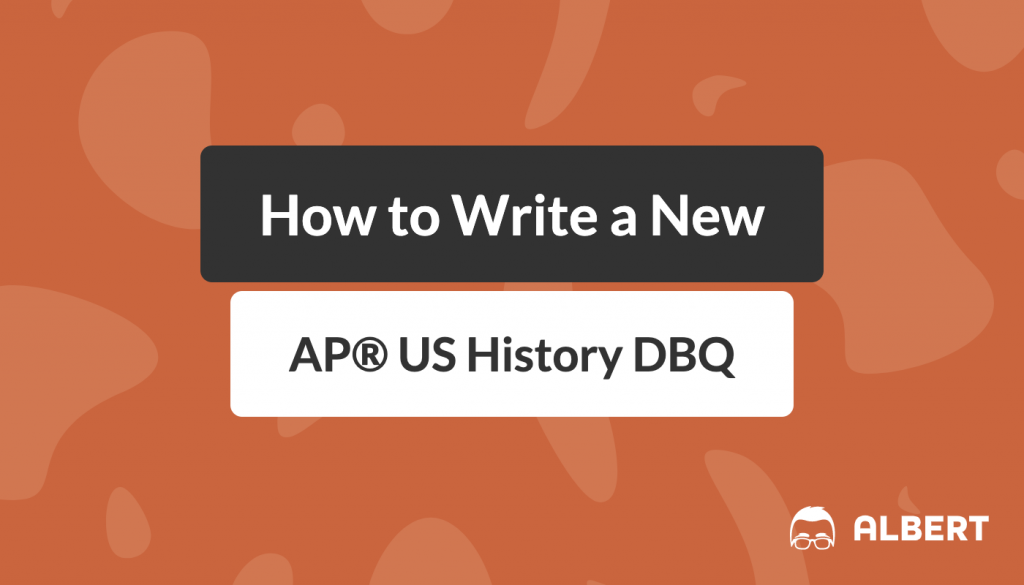Hey! We wrote an updated version of this post here. Check it out for helpful videos and FRQ tips.
The dreaded AP® US History Document Based Question. For years it has struck fear in the hearts of many, turned boys into men and rookie students into old, weathered veterans. Rumor has it that little Jimmy Walker once took the AP® US History exam and when he got to the DBQ section, proceeded to spontaneously combust. Okay, so maybe that is a little dramatic. But the DBQ can be a really intimidating process that stands in the way of success for many students. Lucky for you, with this comprehensive guide, it can be relatively painless, and you will be well on your way to academic success and glory.
To start with, it is a good idea to figure out what exactly you are trying to accomplish on the DBQ. The quickest way to a high score is to know what the test scorers are looking for, and then do it! The rubric for grading the AP® US History DBQ can be found here. Also lucky for you, we broke down the rubric to make it easy to understand. Before you continue through the rest of this how-to guide, be sure to go check out the DBQ rubric guide here.
All right, so now you know what they are looking for and what you are trying to accomplish. Let’s get started.
The DBQ Layout:
Okay, so here’s how it works. Basically, you will be given an essay prompt, a set of primary source documents (never more than 7), and only 60 minutes to come up with a well written, clear and coherent essay response. The general rule of thumb, recommended by the good people at CollegeBoard, is to dedicate about 15 of those precious minutes to planning and the last 45 to writing. That may seem a little overwhelming, but it is totally doable! Especially with these 6 easy steps!
1. Read the Question.
Then figure out what the question is asking you. I can’t stress this enough, figuring out what the prompt is asking you is critical. No matter how good of a writer you are, or how much history you may know, if you don’t answer the question, you are sunk. A neat tip might be to write out in your own words what the question is asking.
As you are reading the question, be on the lookout for which skills they are trying to test you on. Every DBQ is looking to test your skills of historical argumentation, use of historical evidence, contextualization, and synthesis. These things are outlined in the rubric and are consistent parts of every good DBQ. In addition to these critical skills, a DBQ will be looking to analyze one of a number of certain skills. These include: causation, change/continuity over time, comparison, interpretation, or periodization. Don’t waste too much time trying to figure this out, and don’t get so caught up in it that you forget to answer the actual question, just be sure to keep it in mind as you plan out your answer.
That probably seems like an insanely long first step, but all of that will really only take a couple of minutes and set you up to breeze through the rest of the process. Once you have thoroughly read and interpreted the question, you are ready for step number 2!
2. Dig into the Sources
While you want to make sure that you read each document, don’t waste your time on too focused of a reading. Underline or highlight things that stand out, and make notes out to the side. One suggestion is to write a quick sentence or two that summarizes the main idea of each document. And again, this is all just part of the 15-minute planning period; so don’t get too caught up on any document. You are just looking for main ideas and details that really stand out. To take this one step further, you can organize the documents into groups based on their main point. (For highest score possibilities, make sure to use either all or all but one of the primary source documents).
3. Make an Outline.
First decide on a thesis, and from there think about how you want to use your primary source documents to support that thesis. Think about what kinds of outside information you might want to bring in to further support your argument, and where it will fit into your essay as a whole. Once more, don’t get stuck mapping out every single thing that you are going to say, but be sure that you include documents where they fit in the response. This will make it much easier to incorporate them into your answer. Hopefully it has only been 15 minutes or less at this point and you are now ready to write!
4. Start Writing!

Most of your highly intensive, critical thinking type stuff should already have happened and now it is just all about putting those thoughts into words. If you played your cards right and made good use of the first 15 minutes, this part of the process should be pretty straightforward. Start with a brief introduction that gives a little context to the subject matter and shows that you know some of the details surrounding the subject matter. Introduce your thesis, then a few of your main ideas that support your thesis. This part of your paper is not much different than a regular essay response.
5. Keep Writing!
As you get going on some longer paragraphs and stringing together lots of sophisticated and smart sounding sentences, it can be easy to lose sight of the main points of your paper. I have said it a couple times already, but it is absolutely essential that you answer the question!
A few key things to keep in mind as you write your body:
1. Use specific references from your documents, and always show where you are getting the information. At the same time, don’t just use huge block quotes to take up a bunch of space. Use what you need to answer the question.
2. Make sure you use some outside knowledge to support your argument, along with your documents. Specific examples that aren’t on the documents are super helpful in making your argument stronger, and just showing that you know what you are talking about.
3. Don’t forget to contextualize. Things that happen in history are not isolated events, and the circumstances surrounding things matter. Don’t forget to address that.
6. Wrap it up with a ballin’ conclusion.
Don’t draw it out and don’t introduce new ideas in the conclusion. Make it short and to the point. Summarize what your main thesis and arguments were and leave it at that. Don’t try to be too clever or witty or trite and you actually don’t have to use the term “In conclusion” every time you write a conclusion. (Mind blown, I know).
If you follow these 6 easy steps and ANSWER THE QUESTION, you will demolish the DBQ section of the AP® US History exam. (That’s a good thing). And at the very least, you will make it out better than poor Jimmy Walker.
Looking for AP® US History practice?
Kickstart your AP® US History prep with Albert. Start your AP® exam prep today.









4 thoughts on “How to Write a New AP® US History DBQ”
This says it was updated in May of 2020, bull crap! YOu are telling students they have 15 min to read the documents and 45 to write. Thats wrong! They have a total of 45 min. on the new 2020 online DBQ. So Im telling students to spend no more than 19 min with reading the docs. Come on guys! get this updated
I meant 10 min on reading Docs.
Paul, this was written several years ago as noted by the disclaimer. For the 2020 exam, please review our new guide here: https://www.albert.io/blog/ap-us-history-review/
Thanks for the comment!
Paul, this is an article from a few years ago (note the disclaimer). The updates made to this were just images, not core content. Our 2020 AP® US History guide can be found here: https://www.albert.io/blog/ap-us-history-review/
Thanks!
Comments are closed.